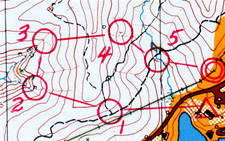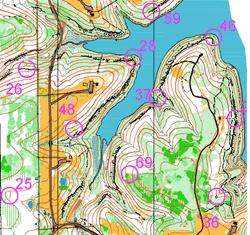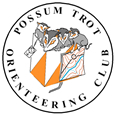Point-to-point orienteering (also called Cross-country orienteering)
In cross-country orienteering the controls (checkpoints) must be taken in numerical order. If the competitor does not find all his checkpoints, he is
disqualified. There is usually a 3-hour time limit.
The following courses are usually available at PTOC events:
- White -- (2 - 3 km) The beginner course. Perfect for those who are unsure of themselves
in the forest or have little or no topographic map experience. It is also for
experienced orienteers 12 years and younger. Routes of travel are along
trails, streams, and other linear features. Navigation is easy and courses are
short.
- Yellow -- (3 - 5 km) The advanced beginner course is designed for experinced 13-14 year
olds and for older teens and adults with some basic knowledge of map and
terrain identification. Navigational problems are easy to moderate and the
competitor will be near easily identifiable re-location features.

- Orange -- (4 - 7 km)The intermediate course is designed for older teenagers and adults
with moderate experience. On this course the competitor will spend the
majority of his time off the forest's trail network and will need to use the
compass extensively. Checkpoints are on major terrain features.
- Green & Red -- (4 - 7 km) The expert courses are all of the same difficulty but
vary in length. The navigation is very tricky with few re-location features.
These courses are designed for older teens and adults with extensive previous
experience and good physical conditioning.
(Regional and national orienteering events may also include the Brown and Blue expert courses. The Brown is shorter in length than Green; Blue is considered the Elite course and is longer than Red.)
Score orienteering
 Another form of orienteering is Score Orienteering. Many controls are placed throughout the area, each having a point value determined by its distance from the start/finish or its technical difficulty. Participants have a set time to find as many controls as they can and earn as large a point value as possible. There is a large point penalty for being over-time. Highest score wins! Another form of orienteering is Score Orienteering. Many controls are placed throughout the area, each having a point value determined by its distance from the start/finish or its technical difficulty. Participants have a set time to find as many controls as they can and earn as large a point value as possible. There is a large point penalty for being over-time. Highest score wins!
Other forms of orienteering There are many forms of orienteering besides the most common: cross-country and score O. There are: relays, night orienteering, cross-country ski orienteering, mountain bike orienteering, horseback orienteering, handicap orienteering (Trail O), long-course, short-course, and sprint orienteering. |



